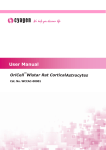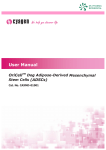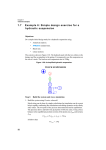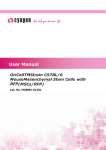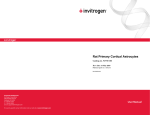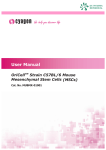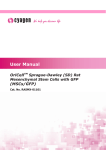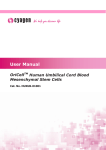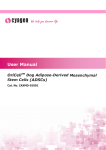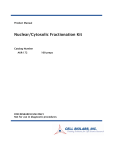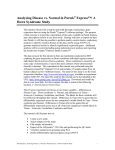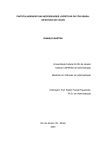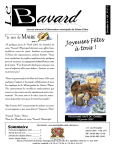Download User Manual - Cyagen Biosciences
Transcript
User Manual TM OriCell Fisher 344(F344) Rat CorticalAstrocytes Cat. No. FCCAC-00001 Table of Contents Contents and Storage…………………………………………………………………………………………3 Product Introduction…………………………………………………………………………………………3 Product Applications…………………………………………………………………………………………4 General Handling Principles…………………………………………………………………………………4 TM Culture OriCell F344 Rat Cortical Astrocytes Thawing and Establishing OriCellTM F344 Rat Cortical Astrocytes… …………………… …4 Passaging of OriCellTM F344 Rat Cortical Astrocytes…………………………………………………6 Cryopreservation of OriCellTM F344 Rat Cortical Astrocytes……………………………………7 Appendix………………………………………………………………………………8 Related Products………………………………………………………………………………………………8 References…………………………………………………………………………………………………………8 Technical Support ………………………………………………………….….…8 CONTENTS AND STORAGE Product Name Fisher 344Rat Cortical Astrocytes Catalog No. FCCAC-00001 Amount per Vial 1×106 Cells Cryopreserved At First Passage Storage Condition Liquid Nitrogen CAUTION: Please handle this product as a potentially biohazardous material. This product contains Dimethyl Sulfoxide (DMSO), a hazardous material, in the freezing medium. PRODUCT INTRODUCTION Astrocytes are characteristic star-shaped glial cells in the brain and spinal cord. They are crucial in forming the blood-brain barrier through biochemical support of endothelial cells, providing nutrients to the nervous tissue, maintaining of extracellular ion balance and healing of the brain and spinal cord from traumatic injuries. OriCellTMFisher 344(F344)Rat Cortical Astrocytes are derived from the cortex of newborn F344rats. They are tested negative for bacteria, fungi and mycoplasma. Activity of CyagenOriCellTMF344 Rat Cortical Astrocytes Recovery Viability ≥80% Can be passaged at least 2 times. Purity of CyagenOriCellTMF344 Rat Cortical Astrocytes GFAP positive cells ≥ 80% β-tubulin IIIpositive cells ≤ 10% GalCpositive cells ≤ 10% This product is intended for laboratory research use only. It is not intended for diagnostic, therapeutic, clinical, household, or any other applications. IMPI0044A2 FCCAC-00001 Page 3 of 8 PRODUCT APPLICATIONS OriCellTM Fisher 344(F344)Rat Cortical Astrocytes can be used to study neurobiology such as the maintenance of the extracellular environment in the CNS and the maintenance of neuronal metabolism and neurotransmitter synthesis, as well as drug discovery in the areasof Parkinson’s, Huntington's and Alzheimer’s Disease. GENERAL HANDLING PRINCIPLES 1. Aseptic handling of the product is necessary throughout. 2. For general maintenance of cells, we recommend the seeding density to be 3.04.0×104cells/cm2. 3. For all studies, it is strongly recommended to use cells that are at, or under, an original passage number of 5. 4. For general maintenance of cells, we recommend that the medium is changed if it becomes acidic (the pH indicator in medium appears yellow). In general, change the growth medium every three days. 5. Do not let OriCellTM F344 Rat Astrocyte overgrow as it will result in contact inhibition. When the cells are 80-90% confluent, subculturing the cells is strongly recommended. Note: We strongly recommend the use of OriCellTM culture media and other related reagents for optimal results. THAWING AND ESTABLISHINGOriCellTM Fisher 344(F344) RAT CORTICAL ASTROCYTES Materials Required: OriCellTM Astrocyte Growth Medium(Cat. No. GXXAC-90011) Thawing and EstablishingF344RatCortical Astrocytes 1. Pre-warm OriCellTM Astrocyte Growth Medium to 37°C. 2. Add 9mlL of OriCellTM Astrocyte Growth Medium to a 15mL conical tube. 3. Remove the cryovial of OriCellTMF344 Rat Cortical Astrocytes from liquid nitrogen. 4. Quickly thaw the vial in a 37°C water bath until the last ice crystal disappears, and finish the thawing procedure within 3 minutes. Be careful not to submerge the entire vial. Maximum cell viability is dependent on the rapid and complete thawing of frozen cells. Note: Results will be less than optimal if the cells are thawed for more than 3 minutes. IMPI0044A2 FCCAC-00001 Page 4 of 8 5. As soon as the cells are completely thawed, disinfect the outside of the vial with 70% v/v ethanol. 6. Use a pipette to transfer the cells to the 15mL conical tube containing OriCellTM Astrocyte Growth Medium inside a biosafety cabinet. Be careful not to introduce any bubbles during the transfer process. 7. Rinse the vial with 1mL of medium to reduce the loss of cell and then transfer this 1mL of cell suspension to the conical tube. 8. Gently mix the cell suspension by slowly pipetting up and down. Be careful not to introduce any bubbles. 9. Centrifuge the cell suspension at 250 x g for 5 minutes. 10. Carefully aspirate off as much of the supernatant as possible and add 2-3mL of fresh OriCellTM Astrocyte Growth Medium (pre-warmed to 37°C). 11. Gently re-suspend the cells in OriCell TM Astrocyte Growth Medium. 12. Seed the cells into a T25 flask and add a sufficient OriCellTM Astrocyte Growth Medium. Gently rock the culture flask to evenly distribute the cells. 13. Incubate the flask at 37°C in a 5% CO2 humidified incubator. 14. The next day, change the medium with fresh OriCellTM Astrocyte Growth Medium (pre-warmed to 37°C). 15. Change the growth medium every three days thereafter. 16. When the cells are approximately 80-90% confluent, they can be dissociated with Trypsin-EDTAand passaged. Note: Changing Medium 1. Warm an appropriate amount of medium to 37°C in a sterile container. Remove the medium and replace it with the warmed, fresh medium and return the flask to the incubator. 2. Avoid repeated warming and cooling of the medium. If the entire contents are not needed for a single procedure, transfer only the required volume to a sterile secondary container. Fig. 1OriCellTM Fisher 344 Rat Cortical Astrocytes are establishe IMPI0044A2 FCCAC-00001 Page 5 of 8 PASSAGING OriCellTM Fisher 344(F344) RAT CORTICAL ASTROCYTES Materials Required: Trypsin-EDTA(Cat. No. TEDTA-10001) Phosphate-Buffered Saline (1×PBS) (Cat. No. PBS-10001) OriCellTMFisher 344Rat Cortical Astrocytes(Cat. No. FCCAC-00001) OriCellTM Astrocyte Growth Medium(Cat. No. GXXAC-90011) Passaging of OriCellTM F344 Rat Cortical Astrocytes 1. Pre-warm the OriCellTM Astrocyte Growth Medium, 1×PBS, Trypsin-EDTA solution to 37°C. 2. Carefully aspirate spent medium from the 80-90% confluent monolayer of OriCellTMF344 Rat Cortical Astrocytes. 3. Add 1×PBS (6mL for T75 flask, 3mLfor T25 flask). Be careful not to disturb the monolayer. Gently rock the flask back and forth to rinse the monolayer. 4. Aspirate 1×PBS and discard. 5. Repeat the step 3-4 two or three times. 6. Add Trypsin-EDTA solution (1.5mL for T75 flask, 0.5mL for T25 flask). Gently rock theflask back and forth to ensure that the entire monolayer is covered with the Trypsin-EDTAsolution. Allow the trypsinization to continue until the majority of the cells (approximately80%) are rounded up. At this point, gently tap the side of the flask to release themajority of cells from the culture surface. Note: Avoid leaving cells exposed to the trypsin longer than necessary. Care should also be taken that the cells are not forced to detach prematurely as this may result in clumping. 7. After the cells are visibly detached, immediately add the pre-warmed OriCellTM Astrocyte Growth Medium (6mL for T75 flask, 3mL for T25 flask) to neutralize the trypsinization. 8. Gently pipet the medium over the cells to dislodge and resuspend the cells. Repeat 5-6 times until all the cells are dissociated from the flask and evenly dispersed into a single cell suspension. Note : Care should be taken to avoid introducing bubble during pipetting. 9. Transfer the dissociated cells into a 15mL conical tube. 10. Centrifuge at 250 x g for 5 minutes to pellet the cells. 11. Carefully aspirate off as much of the supernatant as possible. IMPI0044A2 FCCAC-00001 Page 6 of 8 12. Add 2ml of OriCellTM Astrocyte Growth Medium to the conical tube and gently resuspend the cells thoroughly. 13. Plate the cells into appropriate flasks. OriCell TMF344Rat Cortical Astrocytes can be splitat 1:2 or other appropriate ratio. 14. Add an appropriate amount of medium to the cells. Incubate the cells at 37°C in a 5% CO2 humidified incubator. Additional Tips Time to Change Medium It is recommended tochange the culture medium whenever themediumbecomesacidic, even ifthecellsdonotreach80-90%confluency.In general, change the growth medium every three days. Time to Subculture WhenOriCellTMF344RatCorticalAstrocytes are 80-90%confluent, itisrecommended that the cells be subcultured. Do not let OriCellTMF344Rat Cortical Astrocytes overgrow as it will result in contact inhibition. CRYOPRESERVATION OF OriCellTMF344 RAT CORTICAL ASTROCYTES Note: Change the culture medium with fresh growth medium 24 hours before freezing. 1. Collect cells that are in logarithmic growth phase. Perform a cell count to determine the viable cell density. 2. Centrifuge the cells 3-5 minutes at 250xg, 20°C. Remove and discard the supernatant using a pipette. 3. Resuspend the cell pellet in the OriCellTM Cryopreservation Medium(Cat.No.CRYO10001) at a cell density of 105-106cells/mL. 4. Dispense aliquots of the cell suspension into cryogenic storage vials that are properly labeled. 5. Place the vials in a programmed controlled-rate freezing apparatus and make sure the cooling rate is 1°C/min. 6. After 24 hours, transfer the frozen vials to liquid nitrogen for long-term preservation. IMPI0044A2 FCCAC-00001 Page 7 of 8 APPENDIX Related products Product Catalog Number Trypsin-EDTA TEDTA-10001 Phosphate-Buffered Saline (1 × PBS) PBS-10001 OriCellTM F344 Rat Cortical Astrocytes FCCAC-00001 OriCellTM Astrocyte Growth Medium GXXAC-90011 References Fedoroff, G. and Richardson, A. (1992) Protocols for Neural Cell Cultures. Humana Press, Totowa, N.J. Jeffrey W. Allen,Lysette A. Mutkus, and Michael Aschner.(2001) Isolation of Neonatal Rat Cortical Astrocytes for Primary Cultures.Current Protocols in Toxicology 12. Cyagen Biosciences reserves all rights on the technical documents of its OriCell TM cell culture products. No part of this document may be reproduced or adapted for other purposes without written permission from Cyagen Biosciences. IMPI0044A2 FCCAC-00001 Page 8 of 8









